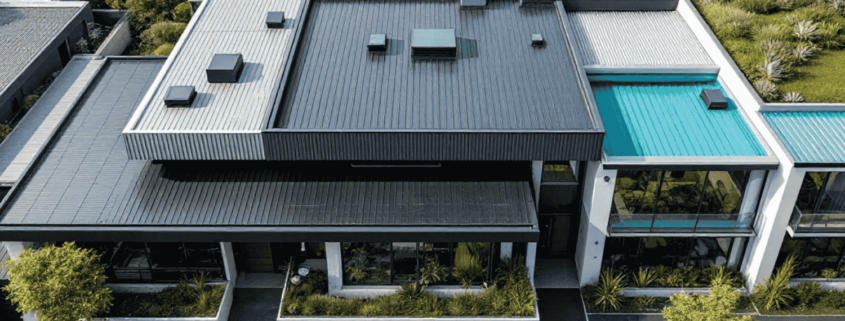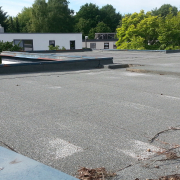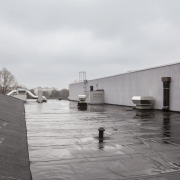Top Benefits & Drawbacks of a House with a Flat Roof
Considering a house with a flat roof? Our guide covers the pros and cons, different types, and essential maintenance tips. Find out if a flat-roof house is the right fit for your home.
Key Takeaways
-
Flat roofs are characterized by their low slope and unique designs, allowing for better maintenance access but posing drainage challenges in wet climates.
-
The main types of flat roofing systems—Built-Up Roofing (BUR), Modified Bitumen Roofing, and Single-Ply Membrane Roofing—each offer distinct advantages to meet varying residential needs.
-
Flat roofs provide benefits such as cost-effective installation, additional usable space, and a modern aesthetic, while also requiring careful consideration of maintenance and climate factors.
What Makes a Flat Roof Unique?

Flat roofs can be constructed on homes, offering a distinctive profile compared to traditional pitched roofs. Architects can experiment with various designs for flat roofs, including completely flat, oblong, and sloping options. The minimal slope of flat roofs, typically ranging between one and ten degrees, sets them apart from a steeply pitched roof. This unique design allows for better accessibility during maintenance compared to steeper alternatives.
Modern flat roofs are flat roof constructed using advanced materials such as concrete, structural steel, rubbers, and synthetic materials, which emerged in the 19th and 20th centuries. These materials are watertight, lightweight, and durable, contributing to the overall uniqueness of flat roofs.
However, flat roofs tend to be less suitable for climates with heavy rainfall or snow due to concerns about water pooling. Despite these challenges, the contemporary aesthetic appeal of flat roofs is increasingly popular in regions like Australia, marking a shift in architectural trends.
Types of Flat Roofing Systems for Residential Buildings
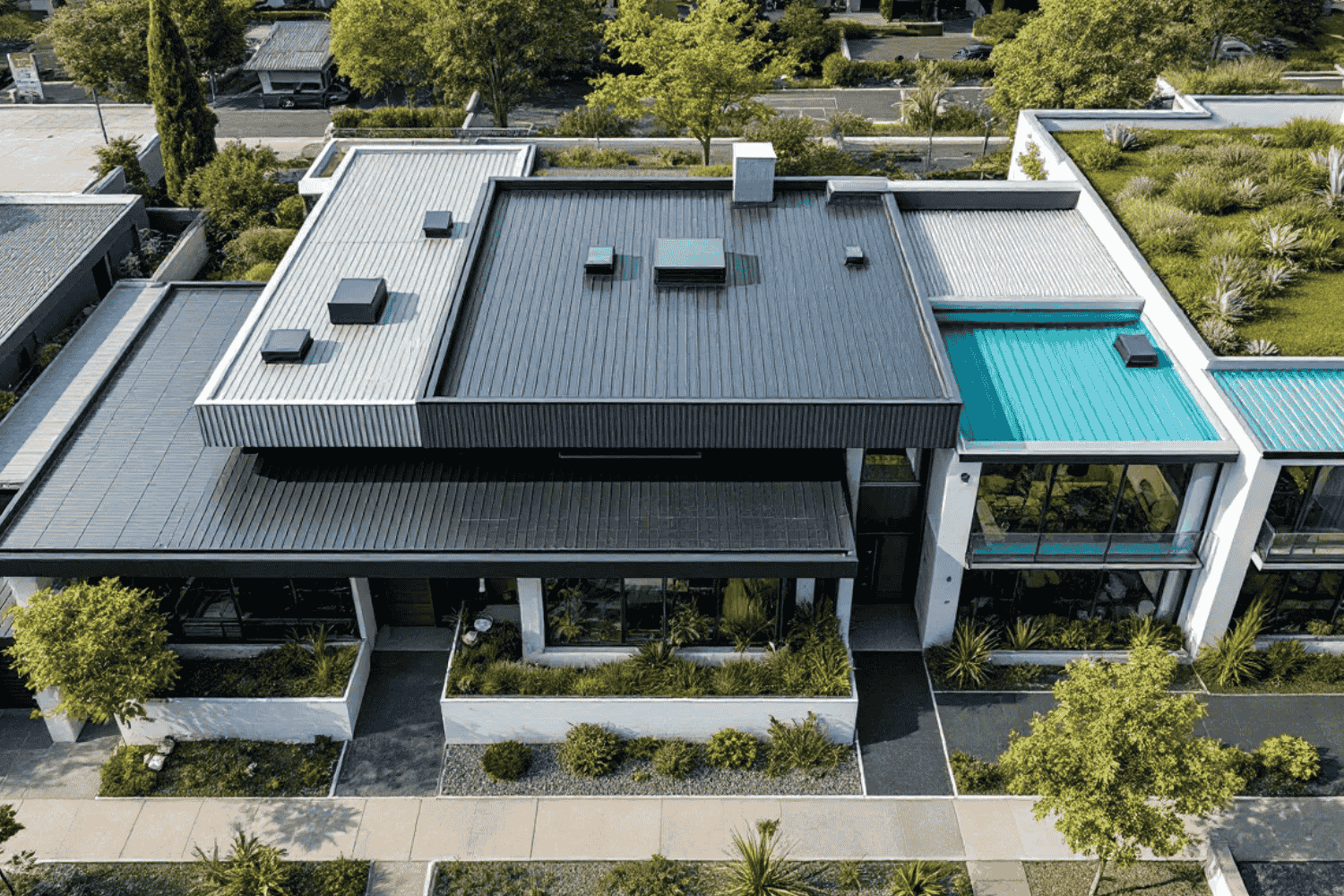
Flat roofing systems are versatile, offering homeowners multiple flat roof type to choose from, each providing unique benefits. The three main types of flat roofing systems for residential buildings include Built-Up Roofing (BUR), Modified Bitumen Roofing, and Single-Ply Membrane Roofing.
Each of these systems has distinct characteristics and advantages, making them suitable for different residential construction needs.
Built-Up Roofing (BUR)
Built-Up Roofing (BUR) is a multi-layer built up roof design used in low slope residential and commercial applications. Comprising multiple layers of felt or fiberglass coated with tar or asphalt and often topped with gravel, BUR systems offer durability and long-term protection.
This type of roofing is particularly favored for its robustness and ability to withstand various weather conditions.
Modified Bitumen Roofing
Modified Bitumen Roofing is a blend of asphalt enhanced with polymers, providing added durability and flexibility. This type of roofing system is easier and faster to install compared to BUR, making it a popular choice among homeowners and roofing professionals.
The enhanced flexibility also allows for better performance in varying weather conditions.
Single-Ply Membrane Roofing
Single-Ply Membrane Roofing includes materials like EPDM, TPO, and PVC, known for their ease of installation and longevity. EPDM roofing, made from synthetic rubber compound, is typically available in large sheets, making the installation process quicker and more efficient.
Additionally, the cost of single-ply membranes is generally within 10% to 20% of other roofing methods, making it a cost-effective option for homeowners.
Pros of Flat Roofs in Residential Construction

Flat roofs provide numerous advantages in residential construction, making them an appealing option for homeowners. A major benefit is the cost-effective installation due to simpler design and fewer materials needed, along with other flat roof options.
Additionally, flat roofs provide extra usable space that can be transformed into outdoor patios, rooftop gardens, or areas for solar panel installations. Flat roof designs also contribute to a clean, modern architectural style, enhancing a home’s overall aesthetic.
Cost-Effective Installation
Flat roofs generally have lower installation costs due to simpler design and fewer materials required. This simplicity results in significant savings during installation, making flat roofs a cost-effective choice. Additionally, the straightforward installation process can often be completed more quickly, reducing labor costs and potential disruptions.
Additional Usable Space
One of the standout benefits of flat roofs is the additional usable space they provide. Homeowners can repurpose this space for various uses, such as outdoor patios, rooftop gardens, or solar panel installations. This additional space enhances the home’s aesthetic value and offers practical benefits, like a private entertaining area typically hidden from view by the front wall.
Modern Aesthetic Appeal
Flat roof designs are closely linked with modern architectural trends, promoting a sleek and contemporary look in homes. Flat roofs create sharp, horizontal lines that contribute to a minimalist aesthetic, which is highly favored in contemporary architecture. This design enhances a home’s visual appeal, making it stand out with clean lines and modern style.
Cons of Flat Roofs You Should Consider
While flat roofs offer numerous benefits, there are also some potential drawbacks to consider. Drainage problems, higher maintenance requirements, and climate performance can affect the overall suitability of flat roofs for some homes. It’s important to weigh these factors carefully to ensure that a flat roof is the right choice for your specific needs.
Drainage Issues
Drainage is one of the most significant challenges associated with flat roofs. Poor drainage can lead to water accumulation and potential leaks, which can cause serious damage over time. Clear debris from the roof surface regularly to prevent clogs and water pooling, which can cause leaks. Keeping the roof surface, gutters, and drains free of obstructions helps prevent water damage.
Maintenance Requirements
Flat roofs require more frequent maintenance to prevent issues such as debris buildup and water damage. Regular maintenance, including debris removal, is essential for maintaining the roof’s integrity and longevity. Inspect flat roofs twice a year and after major rainstorms to address potential issues promptly. Hire a roofing professional for inspections to identify hidden problems not visible during routine checks.
Climate Considerations
The performance of flat roofs can significantly vary based on local climate conditions. Flat roofs are generally less suited for rainy or snowy climates due to their tendency to trap water, which can lead to issues like water pooling and ice dam formation. In colder climates, these challenges are more pronounced, requiring proper maintenance and design adjustments for optimal performance.
Best Use Cases for Flat Roofs
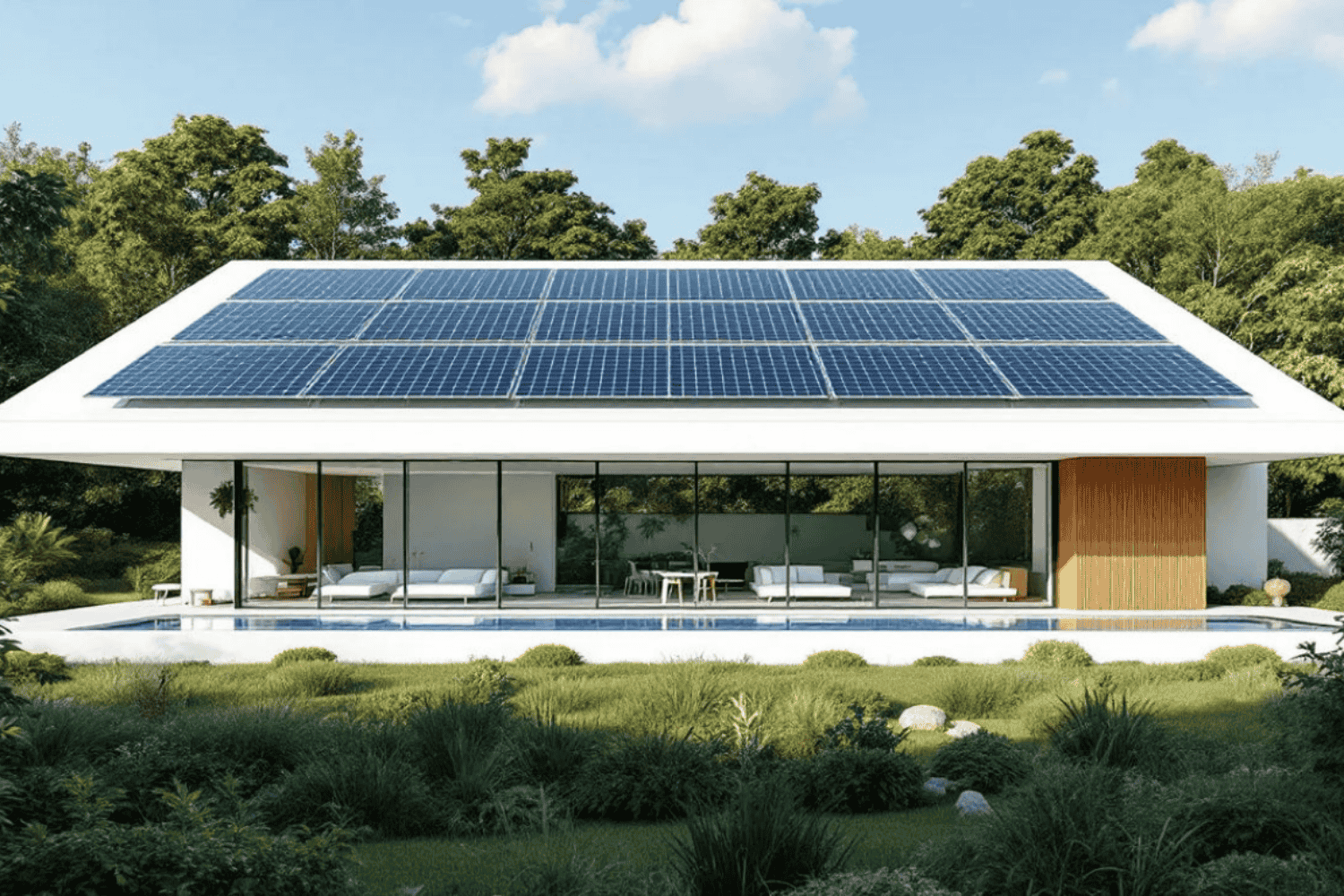
Flat roofs offer versatile applications in various residential settings. They provide additional usable space, which can serve multiple practical purposes, such as a rooftop garden or outdoor living area. Flat roofs can also accommodate features like decks or gardens, increasing livable space significantly.
The contemporary design of flat roofs enhances the aesthetic appeal of modern homes, showcasing various architectural styles.
Urban Residences
Flat roofs are increasingly favored in urban architecture for their ability to maximize usable space. In urban settings where outdoor space is limited, flat roofs provide an excellent platform for rooftop gardens or terraces. This additional space enhances the living quality in urban residences, offering a private outdoor area that can be utilized for various purposes.
Modern Architectural Designs
Flat roofs contribute to clean horizontal lines that enhance the architectural style of contemporary homes. The design of flat roofs supports a minimalist and sleek aesthetic that is highly favored in modern architecture. The popularity of flat roofs in residential homes began to rise in the middle of the 20th century, marking a significant trend in architectural styles.
Eco-Friendly Homes
Incorporating a rooftop garden on a flat roof not only beautifies the home but also offers eco-friendly benefits. Homes featuring green roofs promote environmental sustainability by incorporating vegetation, which can help reduce energy costs and improve air quality. Flat roofs are ideal for installing green roofs or solar panels, contributing to sustainable living and enhancing the overall environmental footprint of the home.
Examples of Stunning Flat Roof Designs
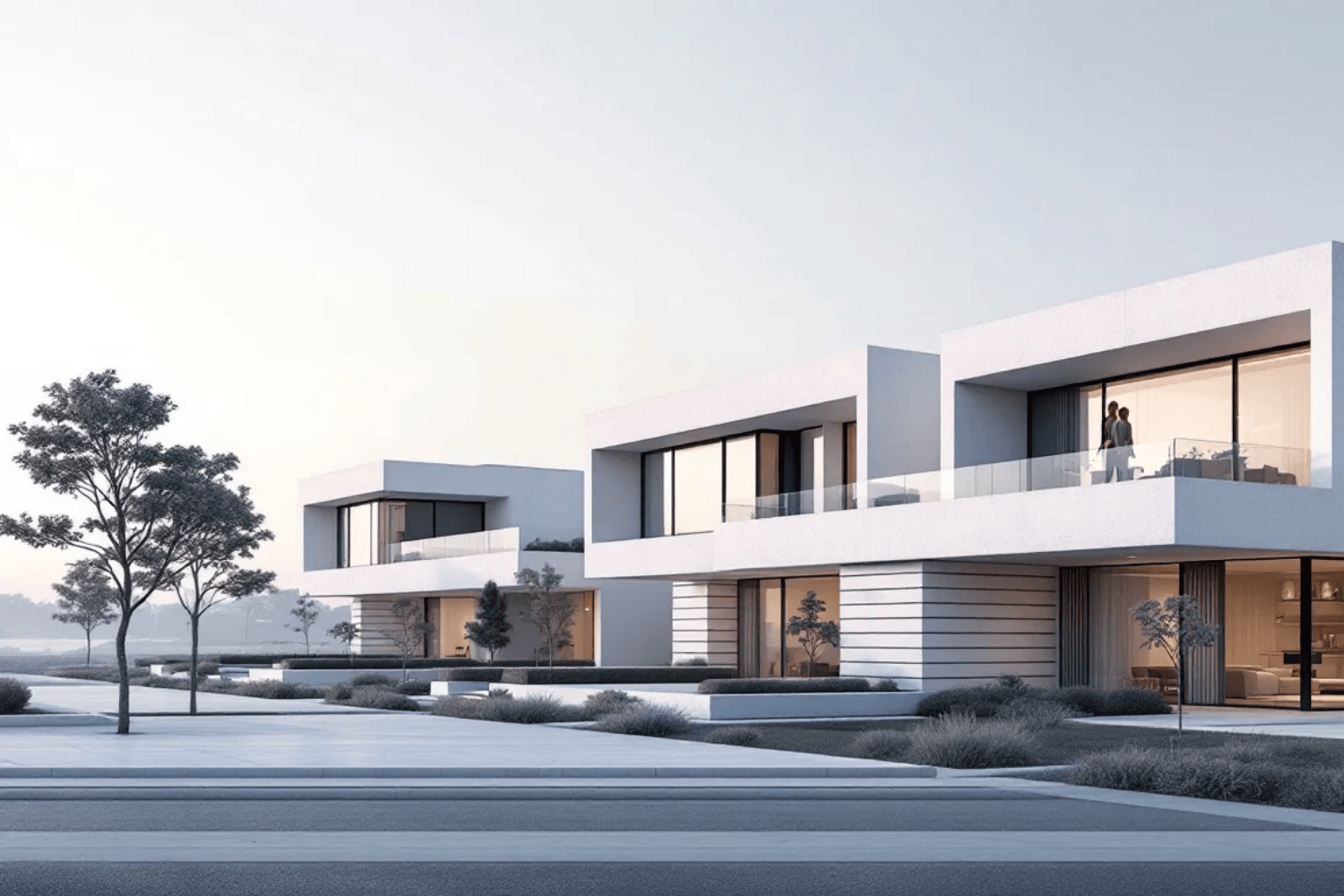
Flat roofs are highly adaptable, allowing for a variety of stunning designs that enhance both functionality and aesthetic appeal. Examples of beautiful flat roof options include minimalist urban homes, green roof oases, and solar-powered houses.
These designs showcase the versatility of flat roofs and their ability to blend seamlessly into modern architectural styles.
Minimalist Urban Home
Minimalist urban homes often incorporate flat roofs to enhance their contemporary styling. Flat roofs contribute to clean lines and a sleek architectural style, supporting a modern and functional lifestyle.
In city settings where space is limited, flat roofs can be utilized for outdoor patios, rooftop gardens, or solar panels, maximizing living space.
Green Roof Oasis
Green roofs are innovative structures that enhance the visual appeal of homes while offering gardening space. Homes featuring green roofs are designed with lush gardens atop flat surfaces, showcasing the potential for ecological enhancements in urban settings.
These green roofs not only improve urban environments by providing space for gardens but also contribute to better air quality and reduced heat absorption.
Solar-Powered House
A solar-powered house with a flat roof can maximize energy efficiency by integrating solar panels directly into the roof design, promoting sustainable living. This approach not only supports renewable energy use but also makes efficient use of rooftop space, contributing to the home’s overall energy performance and sustainability.
Essential Maintenance Tips for Flat Roofs
Regular maintenance is crucial for prolonging the lifespan of flat roofs and addressing potential issues early. Essential maintenance tips include conducting regular inspections, removing debris, and engaging professional repair services when necessary.
Following these tips can help homeowners protect their investment and ensure the durability and efficiency of their flat roofs.
Regular Inspections
Engaging roofing professionals for annual inspections ensures that hidden issues are detected and addressed effectively. Professional inspections should be conducted annually to identify hidden problems not visible during visual checks. This proactive approach helps maintain the flat roof’s integrity and prevent costly future repairs.
Debris Removal
Clearing debris from the flat roof surface prevents blockages that can lead to water pooling and damage. Regular debris removal maintains drainage efficiency, ensuring good roof performance during rain events. Debris can be removed manually or with the assistance of tools like blowers or brooms, depending on the volume of debris.
Professional services for roof cleaning ensure thorough and safe debris removal. Homeowners should inspect and clear debris from their flat roofs at least twice a year to avoid extensive build-up, especially in areas with heavy foliage.
Professional Repairs
Engage a roofing professional to address significant issues detected during inspections. If significant damage is found during inspections or cleaning, contact a roofing professional for repairs.
Engage a roofing expert for repairs when you notice signs of wear or damage to ensure the roof’s durability and functionality.
How Waddle Exteriors Can Help You with Your Flat Roof
Waddle Exteriors provides multifaceted exterior solutions, offering comprehensive flat roofing services tailored to your needs. With over 40 years of experience, Waddle Exteriors guarantees quality and expertise in every project, from consultation to post-installation inspections.
Their collaboration with GAF, a top US manufacturer of roofing materials, guarantees the durability and performance of your flat roof.
Comprehensive Consultation
The first step in transforming your home with a flat roof is a comprehensive consultation where experts visit your home to evaluate your roofing needs. Working with an experienced local roofing company like Waddle Exteriors helps make informed decisions and ensure successful flat roof installation.
Since flat roof installation differs from pitched roofs, having experts in flat roof installed and maintenance is crucial.
Quality Materials from GAF
Waddle Exteriors partners with GAF to provide high-quality roofing materials, ensuring your flat roof is durable and effective. GAF is a leading US manufacturer of roofing materials and building products, known for their durability and performance.
Using GAF materials, Waddle Exteriors enhances the longevity and reliability of your flat roof, providing peace of mind and value for your investment.
Expert Installation and Inspection
With over 40 years of experience, Waddle Exteriors ensures expert installation and thorough post-installation inspections to meet the highest standards. After installation, comprehensive inspections ensure the roofing system performs optimally.
This combination of extensive experience and meticulous inspections gives homeowners confidence in their roofing investment, promoting longevity and performance.
Summary
Flat roofs offer a unique blend of practicality and modern aesthetic appeal, making them an increasingly popular choice in residential construction. Their cost-effectiveness, additional usable space, and contemporary design are significant advantages that can transform the look and functionality of your home. However, it’s essential to consider the potential drawbacks, such as drainage issues and maintenance requirements, to ensure that a flat roof is the right fit for your specific needs.
Waddle Exteriors is here to help you navigate these considerations with expert consultation, quality materials from GAF, and professional installation and inspection services. By choosing Waddle Exteriors, you can be confident in the durability and performance of your flat roof, ensuring that it enhances your home for years to come. Ready to transform your home with a flat roof? Contact Waddle Exteriors today to get started on your journey towards a beautiful and functional flat roof.
Frequently Asked Questions
What type of company is Waddle Exteriors?
Waddle Exteriors is a multifaceted exterior solutions provider, specializing in various services beyond roofing. This comprehensive approach allows them to cater to a wide range of exterior needs.
What services does Waddle Exteriors offer?
Waddle Exteriors provides a full suite of services that includes residential and commercial roofing, along with various roofing types to meet diverse needs.
What is the first step in Waddle Exteriors’ process for home transformation?
The first step in Waddle Exteriors’ process for home transformation is a consultation, during which experts assess the roofing needs of the home. This evaluation sets the foundation for the subsequent work.
How does Waddle Exteriors assist with financing?
Waddle Exteriors assists with financing by helping customers explore tailored financing options that fit their budget after providing an estimate.
Who is Waddle Exteriors’ esteemed partner in roofing materials?
Waddle Exteriors partners with GAF, a leading manufacturer of roofing materials in the United States. This collaboration ensures high-quality roofing solutions for their clients.

